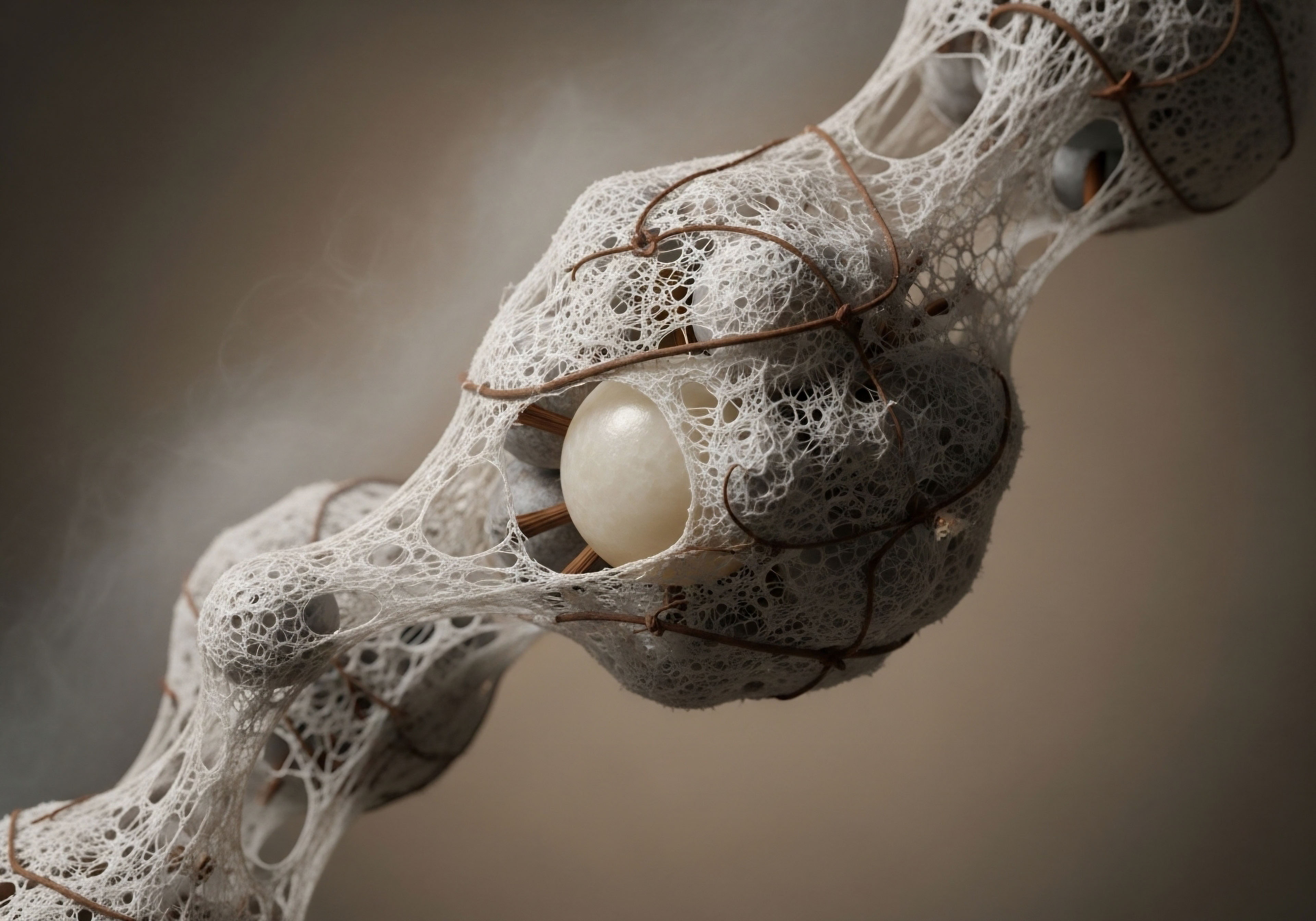

Fundamentals

A Tale of Two Signals
You feel it before you can name it. A persistent fatigue that sleep does not touch, a subtle shift in your mood, or the frustrating reality that your body no longer responds to diet and exercise the way it once did. These experiences are not abstract complaints; they are data points.
They are signals from your body that its intricate internal communication network may be faltering. At the heart of this network are hormones and peptides, the molecular messengers that dictate everything from your energy levels and metabolic rate to your emotional state and physical resilience. Understanding the distinction between therapeutic approaches is the first step toward recalibrating your system.
Standard medical interventions for hormonal decline, such as conventional Testosterone Replacement Therapy (TRT), operate on a principle of substitution. When the body’s production of a key hormone like testosterone diminishes, this approach provides a direct, synthetic replacement to restore blood serum levels to a functional range.
This method is direct and can be profoundly effective for alleviating symptoms of deficiency. It addresses a clear deficit by supplying the missing compound, much like refilling a reservoir that has run low. The goal is to bring a critical system back online by ensuring the final product ∞ the hormone itself ∞ is present in sufficient quantities to perform its duties throughout the body.
Personalized peptide protocols function from a different philosophical and biological standpoint. Peptides are short chains of amino acids that act as highly specific signaling molecules. Instead of replacing the final hormone, peptide therapies use these precise messengers to interact with and stimulate the body’s own endocrine glands, such as the pituitary.
They are designed to encourage your own systems to produce and release hormones in a manner that mimics your natural physiological rhythms. A protocol using peptides like Sermorelin or Ipamorelin, for instance, sends a targeted instruction to the pituitary gland, prompting it to produce and release Human Growth Hormone (HGH).
This approach is about restoring function at a higher point in the command chain, aiming to rejuvenate the body’s innate capacity for self-regulation. It is a conversation with your biology, not a replacement of its parts.

The Body’s Internal Orchestra
Your endocrine system operates like a finely tuned orchestra, with the brain acting as the conductor. The hypothalamus and pituitary gland send out hormonal cues that direct the other instruments ∞ the thyroid, adrenal glands, and gonads ∞ to play their part in harmony. Standard hormone replacement can be seen as boosting the volume of a single, faltering instrument.
For a man with clinically low testosterone, introducing exogenous testosterone brings that instrument back to the required volume, allowing the symphony to continue. The intervention is focused on the output of that one section.
Personalized peptide protocols act more like a targeted instruction from the conductor to a specific section of the orchestra, encouraging it to play its part correctly and in rhythm.
This method respects the complexity of the body’s feedback loops. Hormonal systems are governed by a series of checks and balances. For example, the Hypothalamic-Pituitary-Gonadal (HPG) axis is a self-regulating loop where the brain monitors circulating hormone levels and adjusts its signals accordingly.
Peptide therapies are designed to work within this existing framework. By providing a precise, pulsatile signal, they can stimulate a natural process while allowing the body’s own feedback mechanisms to remain active. This helps preserve the intricate, dynamic balance of the entire endocrine system, preventing the over-suppression or over-stimulation of any single component. The objective is to restore the body’s own intelligent, self-regulating music.


Intermediate

Mechanism and Method a Comparative Analysis
To truly grasp the operational differences between standard hormonal therapies and personalized peptide protocols, one must examine their distinct mechanisms of action at the clinical level. The choice between these modalities is determined by an individual’s specific biological needs, their health goals, and the state of their endocrine architecture. A standard intervention like TRT is a form of exogenous hormone administration, while peptide therapy is a form of endogenous production stimulation.
Let’s consider a common clinical scenario ∞ an adult seeking to address age-related decline in vitality, muscle mass, and recovery, often linked to reduced Growth Hormone (GH) secretion. A standard, though less common and more aggressive, approach might involve direct injections of synthetic Human Growth Hormone (HGH). A personalized peptide protocol would instead utilize Growth Hormone Releasing Peptides (GHRPs) or Growth Hormone Releasing Hormones (GHRHs).

How Do the Protocols Actually Work?
A standard TRT protocol for a male with hypogonadism involves the direct administration of testosterone, typically as Testosterone Cypionate. This molecule is a bioidentical, esterified form of the hormone that is injected intramuscularly. Once in the bloodstream, it directly binds to androgen receptors throughout the body, exerting its effects on muscle, bone, brain, and other tissues.
This approach bypasses the body’s own production system, the HPG axis. Consequently, the brain detects high levels of circulating testosterone and, via negative feedback, shuts down its own signals (LH and FSH) to the testes. To counteract this testicular atrophy and maintain some natural function, protocols often include agents like Gonadorelin or Enclomiphene, which mimic the brain’s signals to keep the testes active.
In contrast, a peptide protocol for GH optimization uses signaling molecules to work with the body’s systems. A popular combination is CJC-1295 and Ipamorelin.
- CJC-1295 is a GHRH analog. It mimics the body’s own Growth Hormone Releasing Hormone, binding to receptors in the pituitary gland and signaling it to produce and release GH. The version with a Drug Affinity Complex (DAC) has a long half-life, providing a steady “permissive” signal for GH release.
- Ipamorelin is a GHRP, or a ghrelin mimetic. It binds to a different receptor in the pituitary (the ghrelin receptor) and also stimulates GH release. Critically, it does so in a very clean, pulsatile manner without significantly affecting other hormones like cortisol or prolactin.
When used together, these peptides create a powerful, synergistic effect. CJC-1295 provides the baseline signal, and Ipamorelin initiates a strong, naturalistic pulse of GH release. This combination respects the body’s innate pulsatile secretion patterns, which is critical for proper physiological function and receptor sensitivity. It stimulates the body’s own machinery rather than shutting it down.

Comparing Therapeutic Philosophies
The following table illustrates the fundamental differences in approach between direct hormone replacement and peptide-based stimulation, using testosterone and growth hormone as examples.
| Attribute | Standard Hormone Replacement (e.g. TRT, HGH) | Personalized Peptide Protocol (e.g. CJC-1295/Ipamorelin) |
|---|---|---|
| Primary Mechanism | Directly supplies a synthetic or bioidentical hormone to the bloodstream, replacing what the body is not making. | Provides a specific signaling molecule to stimulate the body’s own glands to produce and release its own hormones. |
| Effect on Natural Production | Suppresses the body’s natural production of the hormone via negative feedback loops (e.g. HPG or HPA axis shutdown). | Works with and can potentially restore the body’s natural production pathways and pulsatility. Does not typically cause glandular suppression. |
| Mode of Action | Systemic and continuous elevation of hormone levels to a therapeutic range. | Pulsatile and biomimetic, aiming to replicate natural secretion patterns (e.g. a GH pulse at night). |
| Example Protocol | Weekly intramuscular injection of Testosterone Cypionate (200mg/ml) with an aromatase inhibitor like Anastrozole. | Daily subcutaneous injection of a peptide blend like Ipamorelin / CJC-1295, often taken before bed. |
| Ancillary Medications | Often requires additional drugs to manage side effects of axis shutdown (e.g. Gonadorelin for testicular function). | Generally does not require medications to mitigate axis shutdown, as the axis remains active. |
| Therapeutic Goal | To restore serum hormone levels to a specific, stable target number. | To restore the function and responsiveness of the endocrine system itself, with serum levels being one of several markers of success. |
The core distinction lies in working with the body’s control systems versus overriding them.
For women, this distinction is equally relevant. A standard menopausal hormone therapy might involve a steady daily dose of estrogen and progesterone to manage symptoms. A more personalized approach might use low-dose testosterone to address libido and energy, alongside carefully cycled progesterone.
Peptides like PT-141 could be used to specifically target sexual arousal pathways in the brain without broad hormonal effects, while others might be used to improve sleep quality and metabolic function, which are often disrupted during the menopausal transition. The peptide approach allows for a more granular, targeted intervention, addressing specific symptoms with specific signaling molecules.


Academic

The Molecular Dialogue Signal Fidelity and Systems Biology
At the most granular level, the distinction between personalized peptide protocols and standard medical interventions is a matter of signal fidelity and its impact on the complex, adaptive network of human physiology. Standard interventions often introduce a high-amplitude, low-variability signal into a system that evolved to respond to nuanced, pulsatile, and context-dependent information.
Peptide protocols, conversely, are designed to be biomimetic, delivering a high-fidelity signal that the body’s own regulatory architecture can interpret and act upon in a more physiological manner.

Pharmacodynamics and Receptor Engagement
A standard intervention, such as the administration of exogenous Testosterone Cypionate, results in a supraphysiological peak in serum testosterone followed by a slow decline over several days. This creates a relatively stable, yet artificial, hormonal environment. While this effectively activates androgen receptors and alleviates symptoms of hypogonadism, it completely decouples the process from the upstream regulation of the Hypothalamic-Pituitary-Gonadal (HPG) axis.
The constant presence of high testosterone levels leads to a tonic, rather than phasic, engagement of androgen receptors and sustained negative feedback to the hypothalamus and pituitary. This lack of pulsatility can alter gene expression patterns and may not fully replicate the pleiotropic effects of endogenously produced testosterone, which is released in diurnal and ultradian rhythms.
In stark contrast, a peptide like Sermorelin or its more stable analog, CJC-1295 (Mod GRF 1-29), engages the system at the level of the pituitary somatotroph. These molecules are GHRH receptor agonists. Their binding initiates a G-protein coupled receptor (GPCR) cascade, leading to the activation of adenylyl cyclase, an increase in intracellular cyclic AMP (cAMP), and ultimately the synthesis and release of a pulse of endogenous growth hormone.
This process is inherently self-limiting. The released GH and its downstream effector, Insulin-like Growth Factor 1 (IGF-1), exert negative feedback on the hypothalamus and pituitary, inhibiting further GHRH release and GH secretion. This preserves the integrity of the feedback loop. The signal from the peptide is an instruction to initiate a natural process, a process that is still subject to the body’s own sophisticated regulatory controls.
The addition of a GHRP like Ipamorelin adds another layer of physiological sophistication. Ipamorelin is a ghrelin receptor agonist, and it stimulates GH release through a separate but synergistic pathway, primarily involving the Gq protein pathway and increases in intracellular calcium.
The synergy between a GHRH analog and a GHRP produces a GH pulse that is greater than the additive effect of either peptide alone, yet it still occurs as a discrete “pulse.” This biomimicry of the natural dual-control mechanism for GH secretion is a core principle of advanced peptide protocols.

What Are the Downstream Consequences of Signal Type?
The type of signal ∞ a sustained, exogenous replacement versus a pulsatile, endogenous stimulation ∞ has profound downstream consequences for cellular function and long-term adaptation. The table below compares these effects from a systems biology perspective.
| Biological Parameter | Standard Intervention (Sustained Signal) | Personalized Peptide Protocol (Pulsatile Signal) |
|---|---|---|
| Receptor Dynamics | Can lead to receptor downregulation or desensitization over time due to constant, high-level stimulation. Requires careful dose management to avoid this. | Preserves receptor sensitivity by mimicking natural, intermittent patterns of hormone release. The “off” periods are as important as the “on” pulses. |
| Feedback Loop Integrity | Disrupts and suppresses the primary feedback loop (e.g. HPG axis), requiring external management of the consequences (e.g. using Gonadorelin). | Maintains the integrity of the primary feedback loop (e.g. GH/IGF-1 axis). The body’s own “off switches” remain functional. |
| Pleiotropic Effects | May not fully replicate the full spectrum of effects of the natural hormone, as the pattern of delivery is non-physiological. | More likely to produce the full spectrum of physiological effects because the hormone is produced and released by the body’s own cells in a natural pattern. |
| Systemic Adaptation | The system adapts to an external, overriding signal. The body’s own regulatory capacity may atrophy over the long term. | The system is prompted to restore its own regulatory capacity. The goal is to improve the function of the endogenous machinery. |
| Metabolic Influence | Directly alters metabolic parameters through hormonal action (e.g. testosterone’s effect on insulin sensitivity). | Influences metabolic parameters by restoring natural hormonal rhythms that govern processes like lipolysis and glucose homeostasis. |
This is particularly evident in the context of Growth Hormone therapy. Direct injection of recombinant HGH (rHGH) creates a square-wave pattern of GH levels in the blood, which is distinctly non-physiological.
While effective for treating severe deficiency, this pattern can lead to side effects like insulin resistance, edema, and carpal tunnel syndrome, largely because it fails to replicate the natural pulsatility that cells are adapted to. Peptide secretagogues, by inducing endogenous GH pulses, are associated with a much lower incidence of these side effects. The signal’s shape and timing are as important as its amplitude.
The ultimate goal of a personalized peptide protocol is to repair and retune the body’s internal communication network, not simply to bypass it.
This systems-level approach acknowledges that symptoms of hormonal decline are rarely the result of a single, isolated failure. They represent a dysregulation within a complex, interconnected network. By using highly specific, low-side-effect signaling molecules, personalized protocols can address multiple nodes within this network simultaneously.
For example, a protocol might combine peptides for GH optimization (improving sleep and recovery), a peptide for metabolic health (like a GLP-1 agonist), and another for tissue repair (like BPC-157). This multi-pronged strategy aims to restore systemic homeostasis, a goal that is difficult to achieve with single-molecule, high-dose replacement therapies.

References
- Bhasin, S. et al. “Testosterone Therapy in Men with Hypogonadism ∞ An Endocrine Society Clinical Practice Guideline.” The Journal of Clinical Endocrinology & Metabolism, vol. 103, no. 5, 2018, pp. 1715 ∞ 1744.
- Sigalos, J. T. & Pastuszak, A. W. “The Safety and Efficacy of Growth Hormone Secretagogues.” Sexual Medicine Reviews, vol. 6, no. 1, 2018, pp. 45-53.
- Walker, R. F. “Sermorelin ∞ a better approach to management of adult-onset growth hormone insufficiency?” Clinical Interventions in Aging, vol. 1, no. 4, 2006, pp. 307 ∞ 308.
- Teichman, S. L. et al. “Prolonged stimulation of growth hormone (GH) and insulin-like growth factor I secretion by CJC-1295, a long-acting analog of GH-releasing hormone, in healthy adults.” The Journal of Clinical Endocrinology & Metabolism, vol. 91, no. 3, 2006, pp. 799 ∞ 805.
- Raun, K. et al. “Ipamorelin, the first selective growth hormone secretagogue.” European Journal of Endocrinology, vol. 139, no. 5, 1998, pp. 552 ∞ 561.
- Sattler, F. R. et al. “Testosterone and growth hormone improve body composition and muscle performance in older men.” The Journal of Clinical Endocrinology & Metabolism, vol. 94, no. 6, 2009, pp. 1991-2001.
- Jayasena, C. N. et al. “Society for Endocrinology guidelines for testosterone replacement therapy in male hypogonadism.” Clinical Endocrinology, vol. 96, no. 2, 2022, pp. 200-219.
- Sinha, D. K. et al. “Beyond the androgen receptor ∞ the role of growth hormone secretagogues in the modern management of body composition in hypogonadal males.” Translational Andrology and Urology, vol. 9, suppl. 2, 2020, pp. S149-S160.
- Bartke, A. & Brown-Borg, H. “Life extension in the dwarf mouse.” Current Topics in Developmental Biology, vol. 63, 2004, pp. 189-225.
- Sonntag, W. E. et al. “Pleiotropic effects of growth hormone and insulin-like growth factor (IGF)-1 on biological aging ∞ inferences from moderate caloric-restricted animals.” The Journals of Gerontology Series A ∞ Biological Sciences and Medical Sciences, vol. 60, no. 6, 2005, pp. 674-688.

Reflection

Recalibrating Your Biological Blueprint
The information presented here offers a map of two different territories in therapeutic science. One path is well-trodden, direct, and built on the logic of replacement. The other is a newer terrain, based on the principle of restoration and communication. Reading this map is an intellectual exercise, but the territory it describes is your own body.
The symptoms you experience, the goals you hold for your vitality, and your unique biological constitution are the landmarks that will ultimately determine your route.
The journey toward reclaiming your optimal function begins with a deep and honest assessment of your own lived experience. The data from your life ∞ your energy, your sleep, your resilience, your sense of self ∞ is the most valuable information you possess.
Integrating this personal data with the objective findings from comprehensive lab work and clinical evaluation creates a complete picture. This knowledge is the foundation upon which an effective and truly personalized protocol is built. The path forward is one of partnership, a collaborative effort between you and a clinical guide to interpret your body’s signals and provide the precise inputs needed to restore its intended harmony.



